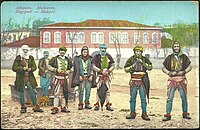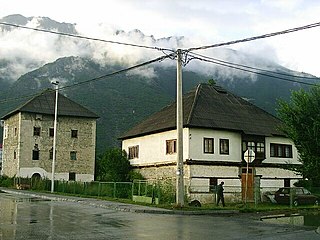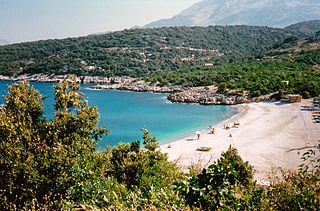| Part of a series on |
| Albanian tribes |
|---|
 |
Kiri is a historical Albanian tribe (fis) and ethnographic region located on the eastern side of the upper Kir river in the wider region of Pulti, northern Albania.
| Part of a series on |
| Albanian tribes |
|---|
 |
Kiri is a historical Albanian tribe (fis) and ethnographic region located on the eastern side of the upper Kir river in the wider region of Pulti, northern Albania.
The Kiri derive their name from the River Kir which flows through the region of Pulti in northern Albania. The river itself is recorded for the first time in Livy's Ab urbe condita (written between 27 and 9 BCE) in the form Clausula. It is later recorded in the 5th century Tabula Peutingeriana as Cleusis. The name appears in later sources from the Middle Ages and into the modern era in the forms of Clyre, Chiri, and Kiri. [1]
The lands of the Kiri are largely located on the eastern banks of the upper Kir and include a number of settlements and mëhallë (quarters): Kir, Nonaj, Kasnec, Lekgjonaj, Telash, Aliaj, Palucaj, Shkuq, Gjeshgoraj, Marknonaj, Palnonaj, Petal, and Prangull. [2]
Despite forming a single military-administrative unit ( bajrak ) in the Ottoman period, the Kiri are not a tribe of the same patrilineal ancestry. [3] According to oral traditions, the current brotherhoods of Kiri arrived during the 16th and 18th centuries. A number of the brotherhoods trace their origins back to the four brothers Ndue, Tel, Byk, and Ali Bezhani. Tradition maintains that they had arrived from Peja in western Kosovo and initially only constituted a single household in Telash. [4] According to Giuseppe Valentini the brotherhoods originating from Peja are called the Petali. [5] On the other hand, another portion of the Kiri claim to have arrived from the Ndrekalorë of Kuči in eastern Montenegro during the 16th century and had first settled in an area now called Stinjok. [6] They are the Nonaj. [7] According to Franz Nopsca, the Kiri descending from Kuči could trace their ancestry back to 12 generations in 1907 (from father to son): Nrekal Kuçi > Petal Nrekali > Vuz Petali > Gjin Vuzi > Pep Gjini > Nre Pepa > Palush Nreu > Nik Palushi > Pal Nika > Lul Pali > Pal Lula > Mihil Pali. Other unrelated brotherhoods include the Kodra and Selimi. [8]
In the Ottoman defter of 1485 for the Sanjak of Scutari the settlement of Klir is recorded in the nahiyah of Petrishpan-ili with a total of 20 households that produced 1100 ducats per annum. The anthroponyms recorded in the register are overwhelmingly Albanian and indicate that the village was not inhabited by a single related fis. Branches of the Bukumiri (Milashi son of Bukmiri, Gjoni son of Bukmiri, Andrija son of Bukmiri) and Prekali (Dimeniko son of Prekali, Gjorgji son of Prekali) tribes were settled in Kiri, while possible members of the Kuči are also attested with Andrija and Pali, sons of Kuça. [9]
Kiri (Chiri) appears in a report of 1671 written by Stefano Gaspari as a settlement with 43 homes and 300 inhabitants. The village had a church dedicated to St. Veneranda. It appears as by 1671 the Kiri had started expanding as the village of Kasnec (Casnessi) is also recorded with 9 homes and 50 inhabitants. The locals of Kasnec had no church and attended mass at the church of St. Veneranda in Kiri. [10]
In 1881 Kiri had 75 houses and 550 inhabitants and as of 1892 the bajraktar was based in Kasnec. [11]

Gusinje is a small town in north-eastern Montenegro. According to the 2011 census, the town has a population of 1,673 and is the administrative center of Gusinje Municipality.

Kelmendi is a historical Albanian tribe (fis) and region in Malësia and eastern Montenegro. It is located in the upper valley of the Cem river and its tributaries in the Accursed Mountains range of the Dinaric Alps. The Vermosh river springs in the village of the same, which is Albania's northernmost village. Vermosh pours into Lake Plav.

Kuči is a historical tribe (pleme) and region in central and eastern Montenegro, north-east of Podgorica, extending along the border with Albania. Its historical center is the village of Ubli.

Mrkojevići is a historical tribal region in southwestern Montenegro, located between the towns of Bar and Ulcinj. The region borders Krajina to the east. The Mrkojevići form a distinct ethno-geographical group with their own dialect of the Serbo-Croatian language, while also exhibiting a degree of bilingualism in Albanian. Their customs are distinct from their neighbouring Slavic and Albanian communities, but they also show influence and contacts with them. In the 400-year Ottoman period, the Mrkojevići converted to Islam, which forms an important aspect of their cultural identity.

Hoti is a historical Albanian tribe (fis) and sub-region of Malësia, a divided area located in northern Albania and southern Montenegro. Its geography is mostly mountainous, but some of its villages are on flat terrain near the banks of Lake of Shkodër.

Berisha is a historical Albanian tribe (fis) and region in Pukë, northern Albania. Berisha is one of the oldest documented Albanian tribes, first recorded in 1242 in Dulcigno. In the Middle Ages, it was widely spread across northern Albania, southern Montenegro and Kosovo. People who traced their origin to Berisha are also found in the coastal trading hubs of Dalmatia in the Middle Ages. Berisha formed its own territorial community in Pukë in the course of the 14th century.

Shala is a historical tribe and region of northern Albania in the valley of the river Shalë, in the Dukagjin highlands. At the end of the 19th century the tribe was Catholic and had c. 3,000 members. Today, descendants are widespread in Kosovo and are concentrated in Shala e Bajgorës.

Krasniqi is a historical Albanian tribe and region in the Accursed Mountains in northeastern Albania, bordering Kosovo. The region lies within the Tropojë District and is part of a wider area between Albania and Kosovo that is historically known as Malësia e Gjakovës. Krasniqi stretches from the Valbonë river in the north to Lake Fierza in the south and includes the town Bajram Curri. Members of the Krasniqi tribe are also found in Kosovo and Northern Macedonia.

The Bratonožići is a historical tribe (pleme) in the Brda region of Montenegro. It appeared during the Ottoman period and was a captaincy of the Principality of Montenegro in the 19th century. Today, it forms part of northeastern Podgorica Municipality. In Montenegro, the majority of people who trace their origin in Bratonožići identify as Christian Orthodox Montenegrins and a part identify as Christian Orthodox Serbs. Brotherhoods (bratstvo) from the historical tribe that settled in Bijelo Polje and became Muslims in the Ottoman period identify as Bosniaks. In the 18th century, many families from the region settled in western Serbia. In Kosovo, a part of the Serbs of western Kosovo come from Bratonožići.

Lohja is a historical Albanian tribe located in a small area of the same name in Malësia, northern Albania.

Bukumiri was an Albanian tribe (fis) that lived in present-day central and south-eastern Montenegro. They were semi-nomadic pastoralists whose social organization was based on kinship around brotherhoods of common patrilineal ancestry. Over time they began to settle permanently and in the 15th and 16th centuries they formed their own settlements mostly in Montenegro, but a few branches also in northern Albania. In later years, branches of Bukumiri are also found in Sandzak and Kosovo.

Shoshi is a historical Albanian tribe (fis) and region of northern Albania in the lower Shala valley. Shoshi is first recorded as a small settlement in 1485. The fis itself traces its origin to the brothers Gjol and Pep Suma. The community of their descendants gradually grew to control part of the Dukagjin highlands. In the 19th century Shoshi also became a bajrak.

Trieshi is a historical Albanian tribe (fis) and region in Montenegro above the right bank of the Cem river near the Albanian border in Tuzi Municipality. It is part of the region of Malësia.

Prekali was an Albanian tribe of the Middle Ages. Their origin was probably in the Dukagjin highlands of northern Albania. Since the 16th century, the Prekali tribe gradually became part of other communities in that region.

Gruemiri is a small historical Albanian tribe (fis) in the former municipality of Gruemirë in the region of Malësia.

Bythëdosi was a historical Albanian tribe in the Middle Ages. They inhabited the Brda (Montenegro) area in central and eastern Montenegro, north-east of Podgorica

Bobi was an Albanian tribe that lived in the Middle Ages. They were the anas tribe of the Shala valley, being gradually expelled by the modern Shala.

The Marsheni were an Albanian tribe of the Middle Ages that inhabited areas of northern Albania and south-eastern Montenegro. The modern settlement of Marshej to the north-east of Koplik and immediate south-east of Gradec in Kastrat takes its name from the tribe.

The Rrjolli is a historical Albanian tribe (fis) and region in Malësia of north Albania. The tribal region is centred along the banks of the Rrjoll river that stems from Mount Bishkaz and empties into Lake Shkodër. The Rrjolli tribe is not a traditional fis in the sense of a community that claims paternal descent from one common ancestor; rather, it is polyphyletic. During the Ottoman period it formed a single bajrak.

The Plani are a historical Albanian tribe (fis) and region in Pult of north Albania. The Rrjolli tribe is not a traditional fis in the sense of a community that claims paternal descent from one common ancestor; rather, it is polyphyletic. During the Ottoman period it formed a single bajrak.